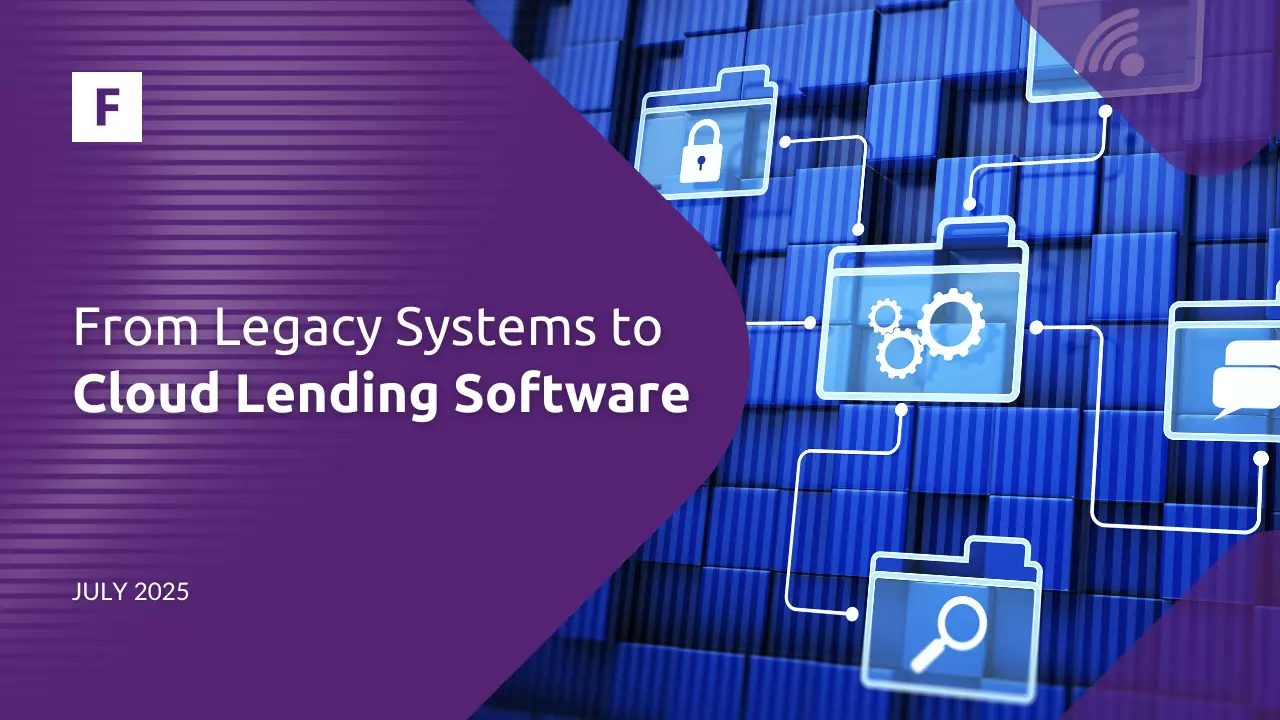Whether you operate a small loan provider, credit union, or a large bank, choosing the right lending software may be one of your most important decisions. After all, without a proper system to handle payments, collections, and tracking loan lifecycle, your lending process could face internal confusion and risk external non-compliance.
For years, in-house solutions have dominated loan management -- a team of in-house developers and lending experts have created and overseeing proprietary lending software. While this has advantages (internal control, full customization, and dedication to security), in-house efforts can be expensive to manage and challenging to scale.
That's why financial institutions are now turning to Software-as-a-Service (SaaS) loan origination systems -- where software is hosted on the cloud, with constant updates and support, but without all of the overhead costs associated with an in-house system.
Organizations that utilize SaaS are quickly discovering the benefits of FinTech loan management systems -- from real-timereporting and tracking of payments and collections to automated processes and streamlining operations.
But is investing in a SaaS loan management system the right move for your institution? How do you begin finding the right one for your loan management needs?
Let's compare in-house versus SaaS loan management systems -- and how SaaS-powered loan servicing enables companies and financial institutions to enhance their technical operations.
What Are Your Options? In-House Systems vs SaaS Loan Management Software
Before evaluating which approach gives you a better value, let's examine each separately. While the latest technology does offer some significant advantages, sometimes the traditional in-house method is a better fit.
In-House Loan Management Systems
Traditional loan management systems are usually owned and maintained in-house, with the source code kept within the institution's control. While this approach can provide more control over data storage, it also requires technical resources to maintain and upgrade the system as needed. Additionally, this approach needs a lot of expertise and skillful software developers because the whole system needs to be built from scratch, and even that's not about it because, over time, the system needs updates, new products, or even compatibility with new markets. Because of that, in-house development is very costly.
In-house loan management typically involves:
Purchasing servers and data center infrastructure
Installing required software and databases
Developing customized interfaces, applications, models, etc.
Integration with existing data storage and finance systems
Managing updates, maintenance, and troubleshooting issues
Pros of in-house loan services systems:
Complete customizability and control: build the system to match your business needs and processes.
Tailored to specific lending workflow needs: rather than trying to fit your business processes with an off-the-shelf system, you can customize and tweak the system to your specifications.
Reduced compliance risk: having control over the entire process allows for better oversight regarding ensuring compliance with regulations.
Cons of in-house loan management:
Major upfront CAPEX costs: You may have to invest heavily upfront when setting up the entire system.
Ongoing OPEX for IT infrastructure and staff: You need to hire IT staff and invest in the necessary infrastructure to keep your system up and running.
Complexity of implementations: Ensuring that a custom system works smoothly can be difficult, particularly when it comes to integrating with existing systems there can be a lot of human error.
Long development cycles to deploy: Depending on the scope of the project, it usually takes at least six months or even years for a custom system to be ready for use.
Internal competition for IT resources: Within an organization, there may be competition for IT resources and attention, which can lead to delays in developing the system.
Read more about the pros and cons of in-house software development from STXNext blog.
SaaS Loan Management Systems
Peter Thiel, co-founder of PayPal once said:"Customers won't care about any particular technology unless it solves a particular problem in a superior way". While in-house loan origination software can be invaluable to the lending experience of an organization, it isn't always the best solution. SaaS loan management systems like Fintech Market lending software offer an all-in-one loan system that allows lenders to use the system to cover all the lending processes with a unified platform.
Usually, custom-built SaaS LMS systems are designed to reduce manual processes and create efficiencies throughout the loan management process. For example Fintech Market consumer lending software has pre-built single-payment and instalment loan types already supported. So the configuration of the lending product is done via selecting the right metrics (interest rates, termination possibilities, payment schedules) for the finalised product. But rather than leave the development of the system to internal IT teams, you can enjoy out-of-the-box solutions that are tailored to meet the exact needs of your loan servicing process.
With SaaS loan management systems, you can allocate more resources to higher-value initiatives and focus on delivering better customer experiences. By leveraging cloud technology, these loan management systems are available anytime, anywhere, from any device, making it easy to stay up-to-date with the latest system enhancements.
Built on shared, cloud-based infrastructure
Pre-built capabilities with APIs for integration
Handled by vendor: uptime, updates, scaling, security
Pay-as-you-go based on usage or subscriptions
Pros of SaaS loan management software:
Low/no upfront costs: With much of the costs associated with traditional loan management systems removed, you can reduce both upfront and ongoing IT investments.
Time to market: You can launch your system quickly without sacrificing features or user experience.
Flexibility and scalability: It's easy to scale up or down as needed, giving you the flexibility to meet changing business requirements
Leverage vendor expertise: Designed by experts in loan management solutions, you can trust your vendor to provide up-to-date best practices.
Improved security: With cloud-based infrastructure and the latest security protocols, you'll you'll have peace of mind knowing your data is secure.
Automation capabilities: You can automate everyday tasks such as loan applications and document tracking to increase efficiency and accuracy.
Multiple markets covered: You can expand to new markets without any hassle because SaaS LMS usually covers more than one market at a time.
Read more about pros of Saas software from IBM blog.
Cons of SaaS loan servicing software:
Less customizable out-of-the-box: While in-house solutions are generally more customizable, vendor loan management solutions are often not as customizable right out of the box.
Dependence on vendor: When you use a vendor's solution for loan management, you'll be dependent on the product and support they provide. However, a lot of vendors offer customer support 24/7.
Less control over specific aspects of the process: While in-house systems mean a lot of internal development and code writing, they do offer fine-tuned customization. You may not have as much control over the final product with a SaaS tool, but you can often request customizations.
The Benefits of Choosing SaaS Solutions for Loan Management
No two financial institutions are the same -- and the same is true for loan management software. While both in-house and SaaS solutions can offer effective and efficient ways of managing loans, SaaS offers a number of unique advantages for those looking to manage their loan portfolio more efficiently.
The Long-Term Cost Savings Are Hard to Ignore with SaaS Solutions
One of the most apparent benefits of SaaS loan management systems is cost savings.
With an in-house system, your organization shoulders the burden of hardware, software licensing fees, integration, maintenance, and IT staff salaries. This requires major capital investments upfront, followed by continual overhead expenses year after year.
You don't have to worry about those details with a SaaS solution. The systems are paid for via monthly or annual subscriptions -- transforming debt and loan management from a capital expenditure to an operating expenditure. Moreover, SaaS vendors can provide better economies of scale, passing those savings down to customers. You benefit from shared infrastructure across the vendor's entire customer base. Cleverdev Software states that custom CRM or BPM software development of the system for a small company will cost around $100K. At the same time if you need a large and complex enterprise CRM solution the price will start from $600K.
Eliminating the high fixed costs of in-house loan management can be especially beneficial for small and mid-sized lenders. Cost savings can free up capital for more strategic lending activities.
Faster Deployment Means Faster Returns on SaaS Investments
In addition to cost savings, SaaS loan management systems typically enable much faster deployments (those necessary to get you up and running) than in-house systems.
This is because the vendor has already done the heavy lifting of system integration, allowing customers to take advantage of an integrated platform solution without going through the process themselves. With SaaS loan management, you can be up and running with a secure, reliable system much faster than if you were purchasing and implementing an internal system on your own.
Rather than waiting through 12-18 month development cycles, SaaS deployments can become operational in just a few months. Some vendors even tout "minutes to production" for simpler needs.
The bottom line? Thanks to process automation, analytics, and improved lending decisions, you start reaping returns on investment much more quickly. Delayed deployments with an in-house option are postponed when benefits start compounding.
Ongoing Support Helps Fast-Track the Lending Process
Once an in-house loan servicing software is deployed, your team inherits all long-term maintenance and update responsibilities. That distracts lending experts with non-core software development initiatives. Not only does this divert focus, but also relies on institutions to attract and retain high-caliber technical teams.
Top SaaS vendors own the technology burden completely. They ensure the loan management software evolves to meet changing needs through ongoing support and regular product updates. Rather than splitting attention between lending operations and software maintenance, teams can specialize in what they do best.
These dedicated vendor resources translate to the customer experience and quicker responses when issues arise. Without support tickets getting lost in an internal IT queue, problems are remediated faster. The same applies to enhancements -- no need to wait months or years for customized upgrades.
SaaS Loan Management Reduces Risks via Security and Compliance
Compliance is key in loan servicing. One wrong move can have catastrophic consequences. When acquiring a SaaS solution, you need to be sure that the vendor you are starting to use is up to date with the latest legislative changes and best practices.
SaaS solutions typically reduce risks compared to in-house options. Strict governance policies enforced by vendors ensure adherence to information security protocols and industry regulations. Change control workflows scrutinize data access and system changes. One good example is Danabijak, which launched its lending operations with the Fintech Market core system. Thanks to a transparent loan management and processing system, they were the first foreigners in Indonesia to get a local lending license and get their business going without waiting for months or years.
Build or Buy: Which Option is Right For You?
FinTech has made great strides in helping lenders streamline lending management. But there's still a dilemma over whether to build their lending solutions or buy solutions for loan servicing software.
As the comparison shows, SaaS loan management delivers a broad range of clear advantages from both cost and risk perspectives. However, in-house systems grant you ultimate flexibility and customization. The "right" choice depends hugely on your institution's specific needs and pain points -- such as scale and complexity.
Carefully analyzing your lending requirements, growth trajectory, appetite for risk, and available tech talent will clarify which option makes sense. If the scales still seem balanced between the two, mixed approaches may provide an ideal compromise.
Modern and no-code Fintech Market SaaS system covers the entire lending lifecycle, from origination to repayment.
Learn more about how Fintech Market can help you manage your loan portfolio and grow your business. The future of loan management is here!
About Fintech Market
Fintech Market (FTM) operates in the lending software market, offering a comprehensive SaaS-based loan management system for financial service providers. It includes essential features such as CRM, KYC, risk management, and debt management for loans, deposits, current accounts, and investments. With tailored solutions to optimize their operations, FTM serves neobanks, SMEs, car leasing companies, and buy-now-pay-later companies in the EU, Mexico, and Indonesia.







